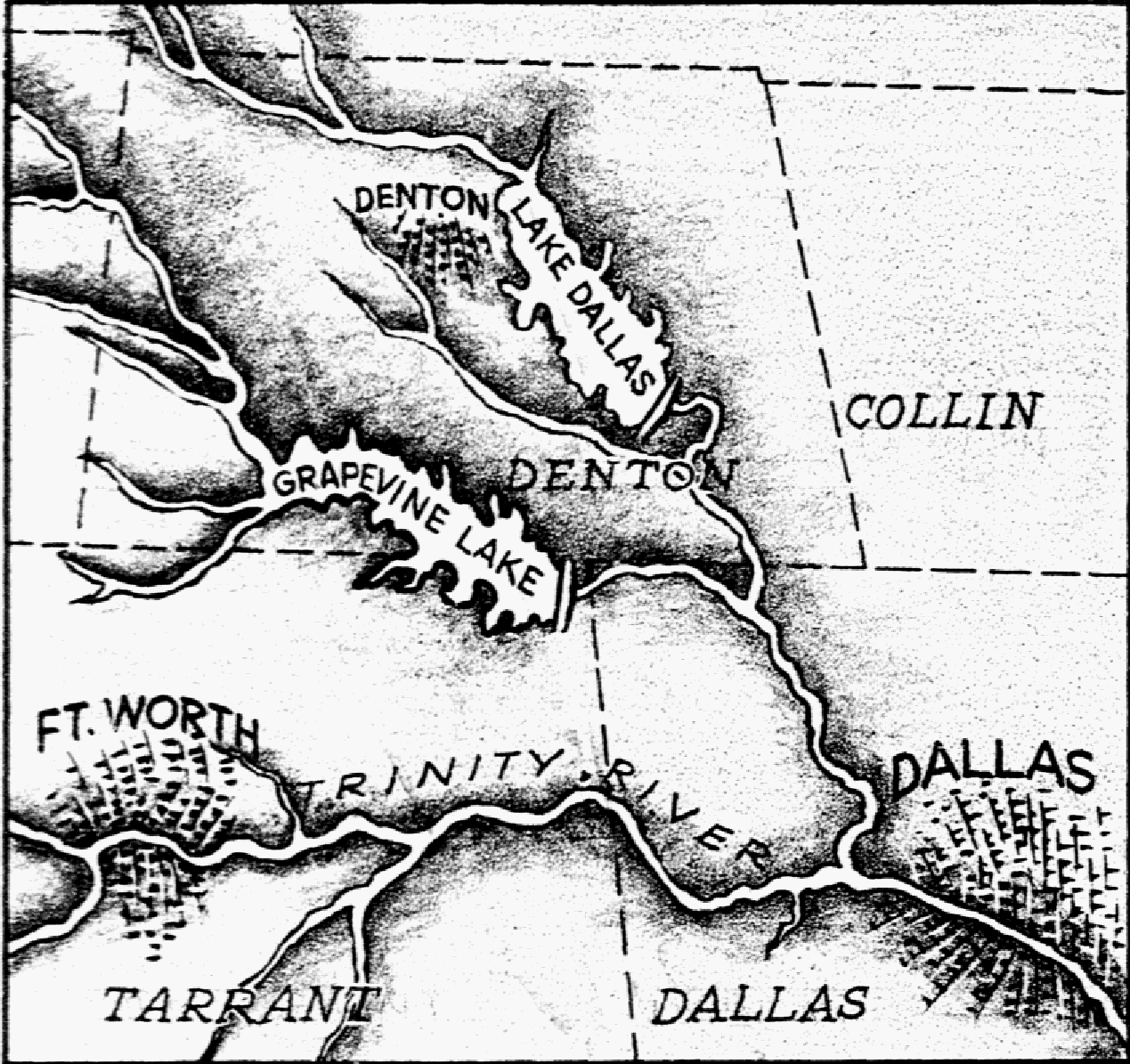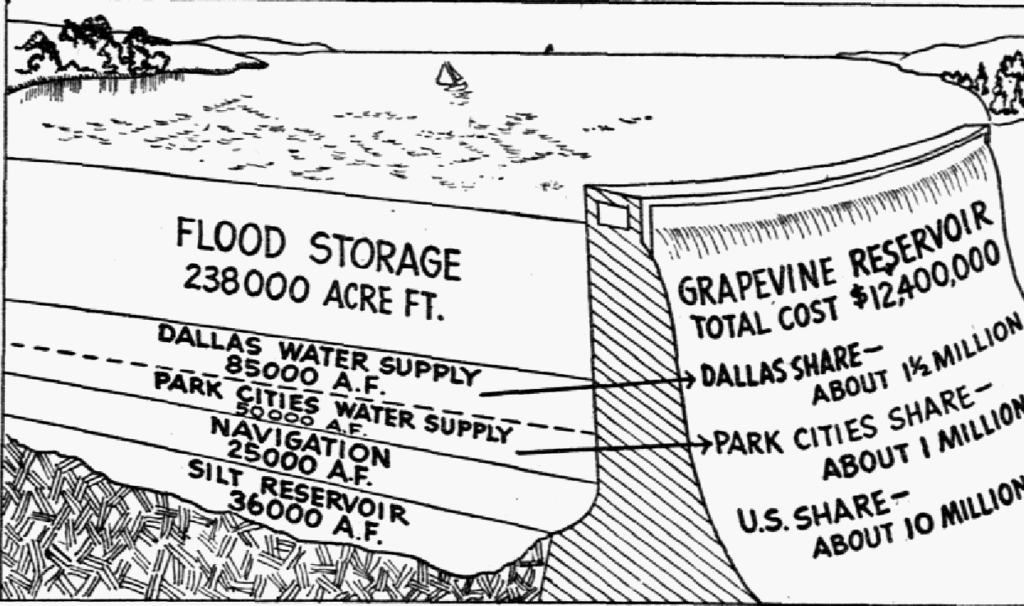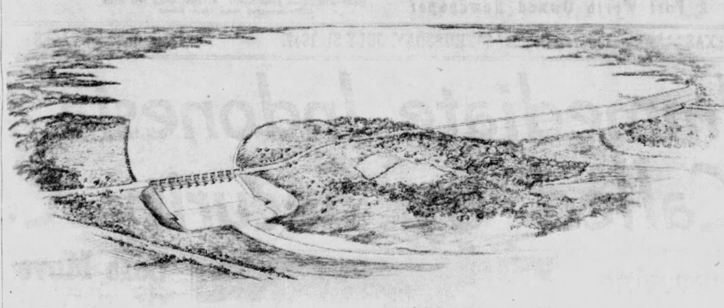Origin and History of Lake Grapevine, 1919-1953, Part 4: Denton Creek Is Surveyed and The Fight For A Dam and Reservoir Heats Up

On March 2, 1945, Congress passed the Rivers and Harbors Act, which authorized among other Texas water projects, the Grapevine Dam project for purposes of flood control and navigation (Fig. 1). Along with the Flood Control Act of 1944, it provided the legislative authority necessary for federal participation in developing the upper Trinity River basin. This Congressional action, according to House Document 403, “Trinity River and Tributaries, Texas,” adopted a “comprehensive plan of improvement” for the basin and authorized the Army Corps of Engineers (ACE) to build of a number of reservoirs and to improve other flood control works on it. This included construction of a nine-foot channel from the town of Liberty to the Houston Ship Channel in Galveston Bay, but not navigation of the Trinity River above Liberty. Since engineers did not make any modifications in the document, “The improvement of the Trinity River and tributaries Texas for navigation, flood control, and allied purpose is hereby approved and authorized in accordance with the reports contained in House Document 403, 77th Congress.” President Roosevelt signed the bill on March 3, 1945, and Trinity Improvement Association (TIA) general manager John M. Fouts continued to work tirelessly to promote this extensive project.

Grapevine Mayor B. R. Wall was not pleased with this news. On April 3, 1945, he confided to his diary that Mr. Fouts would appear at the Grapevine Lions Club meeting on April 10 to promote the project. Three members of the Grapevine City Council would also attended. “Very sorry,” the mayor unhappily wrote in his diary, “that we could not have a more pleasant subject.” Mr. Fouts’s talk, he said, “[d]id not interest me. Consider the whole proposition a wild dream and a reckless waste of money. Such is life, the way the other fellow applies Democracy to his neighbors.”
Let The Surveys Begin
As field surveys began, the activity of the Galveston District of the ACE shifted considerably to Fort Worth. To accommodate the new circumstances, a sub-office was established at that city in 1945, but the headquarters remained in Galveston. E. R. Henderson was in charge of the Fort Worth sub-office’s surveying and mapping section. Field surveys began in July 1945 at the site of Benbrook Dam. The proposed Grapevine dam site surveys were underway as of September 11, but even at that date no money had been appropriated by Congress for the Trinity projects. The ACE moved core boring machinery to the dam site between high bluffs near Grapevine in order to determine foundation materials, and field studies were undertaken to determine the eventual area of the flood control basin. Preliminary estimates placed the cost of the Grapevine reservoir at $3,973,000, and about fourteen months for completion.
A new method for mapping had been recently developed by William T. Ryall, a civil engineer in the Little Rock (Arkansas) District that the ACE found very useful. Called “the method balloon triangulation for horizontal control,” it enabled field parties to complete the mapping for most of a one-hundred-square-mile area of the Denton Creek watershed with significant savings in time and expense since it reduced the need for personnel by fifty percent. The basis of this method was the taking of aerial photographs of the lands to be mapped, but the balloons, four feet in diameter, were the real key to success. Balloons were used in heavily-wooded, unusually hilly country, of which the Denton Creek area provided a prime example (Figs. 2-5).

Fort Worth Star-Telegram, November 25, 1945.
These balloons, however, did not go unnoticed by Grapevine area residents. Some locals bombarded the mappers with questions, and one or two residents even suspected the workers’ equipment of being Japanese balloon bombs that managed to drift to that part of the country.
In The Meantime…
On Wednesday, January 30, 1946, the way was cleared for the US House of Representatives to wipe out the limitation of six months after the war ended before appropriating $381,968,332 for the rivers and harbors project. The Senate had already eliminated that restriction, so Congress could start voting on funding the Trinity River basin strategy. Mayor Wall thought the funds would be better spent on reducing the national debt. That being said, he and other Grapevine civic leaders intended to plan a cooperative program with landowners, including newcomers from Dallas and Fort Worth, to develop a high-class residential area around the proposed lake. New industries were also edging into Grapevine. Mayor Wall warily observed that one of them would be “the manufacture of cement building block and tile, if the proposed lake does not put all of our gravel pits out of business.”
In early April 1946, owners of farm lands along Denton Creek invited representatives from the engineering sub-office in Fort Worth, the Soil Conservation Service, and the TIA to tour the erosion-scarred lands in Montague and Wise Counties that were annually sending silt downstream. (The headwaters of Denton Creek are in Montague County.) These landowners intended to make a case at for the ACE to clear Denton Creek and to keep it unobstructed and clear of sand. Another reason for their concern was that deep, fast-forming gullies on Denton Creek’s upper region, as well as sand-filled valleys, were a threat to both productive farmlands downstream and the up-and-coming reservoir construction program.
In anticipation that the dam and reservoir would resolve this problem, the real estate market took advantage of the situation. An advertisement appeared in the April 14, 1946 Fort Worth Star-Telegram describing the sale of a “30-acre gentleman’s country estate . . . About 400 ft. of this will be lake front property when the Grapevine reservoir is completed.”
At the same time, the Park Cities (Highland Park and University Park) were looking for a water supply independent of Dallas, and had planned to build their own reservoir before becoming aware of the Grapevine reservoir project. Once they were informed about it, they requested confirmation of a previous agreement allowing priority on 50,000 acre-feet of water from that place. They would share the cost, $607,000, to obtain their own water. They wanted construction to begin as soon as possible, since their water contract with Dallas would lapse in 1950, and having recently voted against annexation by Dallas, they were anxious about the possibility that that city would use the water situation “to get us into Dallas.”
On April 16, delegates from nine Texas counties in the upper Trinity region watershed met in Denton and voiced strong support for the soil conservation and flood control program to be undertaken by the ACE. The meeting was called to consider additional improvements and future recommendations if economically justifiable. Mayor B. R. Wall, his brother-in-law Robert E. Crews, and dairyman Carl Simmons – all landowners along Denton Creek – also attended. Of those present, the mayor voiced the only opposition to the program. He suggested that the dam site be moved eight or ten miles upstream where land was not so valuable, claiming that dam construction would mean “great sacrifice for little return.” He claimed that “the lake would cover 16,000 acres of land, including pecan groves, dairy and truck farms, and gravel pits, would necessitate the relocation of roads[,] and would require revamping of the Grapevine sewer system.” On May 31 he observed in his monthly column in the Grapevine Sun that “[t]he movement to get the proposed Denton Creek retarding dam moved up the creek for a more practical location is finding substantial support.” Even so, the proposed dam would be built where it was originally intended to go. In July Mayor Wall reported getting Trinity River “’development literature’” on a regular basis but not much about the war debt, on which he believed the money for the Trinity project would be better spent.
Great Expectations
In August 1946, the ACE announced that plans for the Grapevine and Little Elm (in Denton County) Reservoirs were in the advanced stage and would be ready by January 1, 1947. J. A. Cotton of the Fort Worth sub-office of the Galveston District said that the greatest flood control benefit to Dallas would come from these two reservoirs. Mayor Wall was not convinced of this, nor could he find any answers to questions he posed about its cost in terms of money and land. In his column of September 27, he revealed that “Last week we spent one day in Fort Worth and a few hours in Dallas without finding out exactly when the fertile Denton Creek valley will be submerged with something near unto tidewater, or an accurate estimate on the cost thereof, in such cases made and provided. In the meanwhile some of the war debt will likely be further extended. Quien sabe?” His frustration was again manifested a week later when he wrote that “We, as yet have no definite bona fide estimate on the cost of the proposed Trinity River and Denton Creek dams.” Then, in a cynical note, he added, “‘Dam’ is the name of a coin originally used in India which was worth fifty-eighth (1.58) of a cent in American money.” This coin has been thought be a possible source for the English phrase “I don’t give a dam[*],″ due to its small worth.
By early January 1947, planning for the Grapevine Reservoir was ready to be sent to the chief of engineers the following March, with provisions being made for water storage for the Park Cities and Dallas depending on additional appropriation of funds. Dam construction would begin in 1947 if Congress was willing to make the money available. Plans began to crystallize in late January when Dallas officials and ACE engineers met to plan for an early start on the dam before Dallas’s current water source, Lake Dallas, reached its safety limit in 1954. Colonel D. W. Griffiths, district engineer at the ACE office in Galveston, said he would be ready to start in the fiscal year starting July 1, 1947 if funds were available. TIA general manager John M. Fouts said that he, as well as the mayors of Dallas, each of the Park Cities, and other Dallas officials would go to Washington in June to make this request before a rivers and harbors sub-committee of the House Committee on Appropriations. He said the sub-committee would be asked for at least $1,000,000 for the dam and reservoir when it convened on June 11, 1947.
About the same time, after a nine-year struggle, on June 3 the Texas Legislature approved the Park Cities’ request to set up their own water district on June 3, 1947. Known as the Dallas County Park Cities Water Control and Improvement District No. 2, this entity gave them water rights to 50,000 acre-feet of water in the Grapevine Reservoir in exchange for a payment of $607,000. They were interested only in a dam large enough to supply water for domestic use, whereas the Grapevine project would provide flood control as well as water for Dallas and the Park Cities. These cities stressed two points in their request for the funds it would take to begin this work. The first was that water for domestic purposes was urgently needed. The second was that money would be saved by undertaking the project now. (Congress had previously authorized the project but had not funded it.)
Wingate H. Lucas, a native of Grapevine, had been elected to the US House of Representatives from the Texas Twelfth Congressional District in August 1946. He would later testify in support of the Grapevine Reservoir, as well as ask for additional funds for the Benbrook Reservoir. Fritz G. Lanham, whom Lucas succeeded and was then the Washington representative of the TIA, gave the opening presentation to the House sub-committee of the Dallas and Park Cities case for the Grapevine project. He explained that Dallas would have to spend $5,000,000 and the Park Cities $607,000 for new water-supply dams if the federal government did not expedite the Grapevine project. The reservoir had not been included in recommendations by the ACE for starting in 1948 because President Truman had deferred such projects as had not already been started in order to reduce federal spending. The idea was to get Congress to authorize the funds on its own account, such as transferring some of the funds for the Benbrook project to a cooperative fund that Dallas and the Park Cities could join for starting the Grapevine project.
Lieutenant General R. A. Wheeler, Chief of Engineers of the ACE, briefly described the Grapevine Reservoir project to the committee. He stated that the dam would be of earth-fill construction 12,800 feet long and 137 feet high with a concrete spillway. The reservoir would have a total capacity of 434,200 acre-feet, of which 238,200 would be reserved for flood control, 160,000 acre-feet for conservation, and 36,000 acre-feet for sedimentation reserve, and would cover approximately 20,000 acres. Its estimated cost would be $12,678,400. Wheeler assured the committee that about $1,000,000 could be economically spent to complete plans and specifications for the embankment, spillway, and relocations; excavation for the spillway structure and partial construction of the dam embankment; and acquisition of lands and rights-of-way for the dam site. The reservoir areas themselves would be acquired by the federal government.
During this hearing, a telegram from Mayor Wall was read aloud. “As a taxpaying citizen,” it stated, “ I protest against the appropriation of any Federal funds for the proposed Grapevine Dam in connection with the so-called Trinity River development plans.” Fritz Lanham promptly discounted that statement, saying that “in any place where a dam is to be built there will be some who take exception to it,” and besides, the ACE had already determined the project was justified. The hearings continued without further comment on the mayor’s statement.
The committee next heard from Congressmen J. Frank Wilson of Dallas and Wingate Lucas of Grapevine. Wilson called Grapevine “very beautiful farm country,” with “thousands and thousands of fine black farm lands flooded” by Denton Creek and contributing creeks. As a native of Grapevine, Lucas was able to speak with some knowledge about the proposed dam:
It has been a subject of discussion in my hometown ever since I was a child. In fact, when I was born my mother had trouble getting somebody to stay with her because there was a large flood on Denton Creek out north of town, this very creek that is going to be dammed up. I have been told that this flood was of such proportion that the people remembered it for years thereafter. But 2 or 3 years ago we had another flood there, which they said was larger than the one in 1908.
It is a creek that has floods of such immensity that it contributes a large portion of the damage done downstream.
Lucas went on to say that some Grapevine merchants were objecting to the dam because they said it would cut off their trade area north of town. He stressed that if the Park Cities were to build their own dam without government help, the dam would be below where they had the right-of-way or below a line north of Grapevine that actually would cut off trade territory in Denton County. The ACE’s plan was to build west from the north line of Grapevine and leave those passageways open. Lucas also offered to answer committee questions about local geography or local attitude towards the project, but he could not say what shape local residents would be in to provide lands for the reservoir. However, he strongly recommended that the people who lived along Denton Creek and downstream from it be protected from the almost yearly damage the creek was known to do.
ACE Colonel Peter A. Feringa asserted that the federal government could acquire the land comparatively easily. For the conservation pool, he said that 5,107 acres would be needed, and lands with scattered timber would be 2,270 acres. Including the flood control part of the reservoir, the cleared land would be 10,600 acres and the wooded land 10,762 acres. One cemetery and about 856 people would be directly affected.
Disappointment . . . But Not For Long
After making a final plea for federal funding of the reservoir and dam project on June 11, the delegation returned to Texas with some disappointment. They reported having been hurried along and not given adequate time to present a good case. By the end of June 1947, funds had been appropriated for the Benbrook and Lavon Dams but not for Grapevine, as it was not then under construction. Representative Wilson of Dallas vowed to carry the fight for the Grapevine Dam to the Senate when he saw that provisions were being made for several other projects not under construction. He emphasized that in the past the Senate had been more generous with river, harbor, and flood control appropriations than the House, such that funding would stand a good chance of remaining in after House-Senate compromise. He would also call back Dallas and Park Cities officials as well as Representative Lucas to assist him.
On July 11 and 12, Lucas, Wilson, Lanham, and Texas Senator Tom Connally each made a case before the committee; their efforts would be the last hope for the 1948 fiscal year that began July 1, 1947. Connally said he would urge the Senate Appropriations Committee to match dollar-for-dollar the $500,000 that Dallas and the Park Cities were willing to spend to start immediate construction on the Grapevine Dam. Dallas had agreed to pay $1,500,000 to guarantee an allocation of 85,000 acre-feet of water storage. Lanham drove home the urgent need for federal funding by emphasizing that beside the great loss of life, the completed reservoir would cost less than the property damage losses that the ACE estimated could result from a single Dallas flood.
Another compelling reason for the Dallas delegation to urgently request immediate appropriations was that if the Park Cities was forced to construct a much-needed smaller dam for their own use, that action would preempt the best location for the dam on Denton Creek. Those cities would build one and one-half to two miles downstream from the Grapevine Dam’s targeted location, and result in duplication and waste of money when the federal government did get ready to build. The seriousness of the situation became more apparent when the Park Cities prepared to vote on a $7,000,000 bond issue to pay for their own water system should the Grapevine project fall through.
The delegation’s efforts paid off. On July 21, the Senate sub-committee approved the $500,000 to initiate work on the Grapevine Dam, and the full Senate Appropriations Committee followed suit on July 22. The bill then passed to a conference with the House in order to effect a workable compromise. Since the Grapevine project was finally approved, the Park Cities would not have to pay for and build a dam on their own.
Construction of the Grapevine Dam and Reservoir was scheduled to begin by late November 1947. Most of the dam, spillway, and outlet works would be in Tarrant County, while the larger part of the reservoir would spread out across Denton Creek’s watershed in Denton County. To build the dam, 2.4 miles of railroad would have to be abandoned and 2.37 miles of new line would need to be replaced. It would also be necessary to relocate 2.6 miles of federal highway, 1.9 miles of country roads, 20.3 miles of power lines, 10.9 miles of telephone lines, and 2.3 miles of telegraph wires. ACE plans and specifications for the dam called for its completion within three years.

Fort Worth Star-Telegram, July 31, 1947.
The back-to-the-land movement described in the previous blog showed no signs of slowing down in 1947. Grapevine banker David E. Box conservatively estimated the number of Dallas landholdings in Grapevine at over 25,000 acres. “The entire Grapevine sector for eight miles around the town,” he explained, “is completely dominated by Dallas land owners.” Now that the dam and reservoir project was underway, the scenery was about to change.
Many of those Dallasites and Grapevine landholders would eventually see their lands along Denton Creek submerged under soon-to-be Lake Grapevine. In the next blog, we will see how “eminent domain” became a familiar term to these people as heavy earth-moving machinery began to appear on the landscape.





Recent Comments